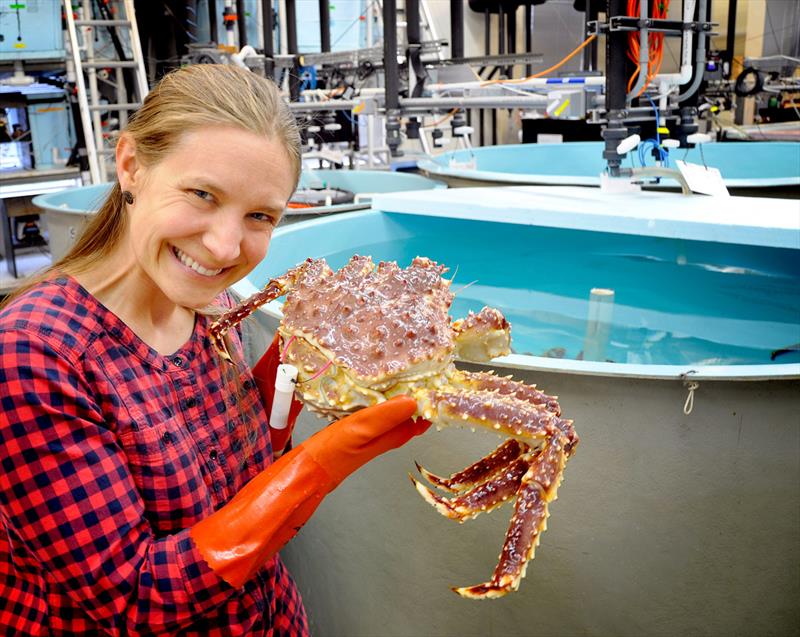
Saildrone set to track Alaska red king crab
by NOAA Fisheries 16 Jun 2019 14:10 UTC

NOAA Fisheries scientist Leah Zacher tests a trial tag on a female red king crab © NOAA Fisheries
Fishing industry and researchers team up to track red king crab seasonal movements to provide data vital to keeping the Bristol Bay fishery sustainable in a changing climate.
Alaska red king crab and the perils that fishermen face to catch them have gained worldwide fame. But fishermen are also working hard, together with NOAA Fisheries, to keep red king crab populations healthy and sustainable.
Reasons for declines in Bristol Bay red king crab stocks over the last decade are not well understood. Very little is known about how recent environmental variability drives crab seasonal movements, habitat use, and interactions with groundfish trawl fisheries.
NOAA Fisheries is partnering with the fishermen-supported nonprofit Bering Sea Fisheries Research Foundation to find answers to these unknowns. We are launching research to track the movements of adult male red king crabs in Bristol Bay using an unmanned surface drone (Saildrone, Inc.). Their findings will provide information crucial to keeping red king crab sustainable in a changing climate.
"So little is known about where crabs are and how they move. We have only snapshots from summer surveys. This research will fill in the life history gaps to better inform the management of red king crab as both target and bycatch," said Scott Goodman of Bering Sea Fisheries Research Foundation.
"Managers need to understand where crabs go in different seasons, and what habitats are essential, to set effective rules for fishing," said NOAA Fisheries scientist Leah Zacher, who is leading the project. "Everyone benefits from increasing our knowledge of crab distributions."
Tag and Seek: Tracking Seasonal Movements of Crabs
Scientists will be working with fishermen in June to tag crabs with acoustic devices that transmit an ID number and the bottom temperature. Tagging is timed right after the NOAA Fisheries summer survey so researchers will be able to target where crabs are most abundant.
The team will deploy the saildrone, equipped with an acoustic receiver, in October 2019 and again in April 2020 to relocate the tagged crabs.
"We know where crabs are in the summer from annual NOAA Fisheries surveys, but there is little information for the rest of the year. We will relocate the crabs in the fall to understand how crabs move onto the fishing grounds, and in the spring to determine their locations when they are vulnerable to being caught as bycatch in trawl fisheries," Zacher said.
The saildrone, contracted and funded by Bering Sea Fisheries Research Foundation, provides invaluable capabilities to make the search, and the research, possible.
"We have a huge area to search for moving targets in an ever-changing environment. Traditional tag and recover methods require an enormous investment of time. You are dependent on the crabs being caught in a fishery and the tags returnedyou never know if or when the tags will come back. Tracking crabs acoustically from a manned vessel would be unfeasibly expensive," Zacher explained. "With a saildrone we can cover huge areas cost-effectively, at the times when we need data."
"This technology will collect many data points for each crab released. It is a new paradigm for tag release and recovery studies," Goodman said.
Essential Habitat in a Changing Climate
An important outcome of the research will be finding out what habitats are essential for Bristol Bay red king crab in different seasons, and whether current protected areas are effective.
Temperature information transmitted by each tagged crab will help determine how temperature influences crab movement among key areas. The team will also compare crab locations with sediment maps to identify the characteristics of essential habitat.
The study will also show whether protected areas are in fact protecting crabs.
"The Red King Crab Savings Area is closed to trawling to provide a protected habitat. But the area was initially set based on limited information, and since then the climate has changed, the environment is changing. Managers need to know if and when red king crabs are moving through and using those areas to know if they are effective," Zacher said.
Understanding how crab movements are affected by climate is a longer-range goal of the study. Warm conditions are projected for the Bering Sea in 2019, so the team will document habitat use and movement under a warm regime. This can be compared to future tracking efforts in cooler conditions.
Additional Resources: